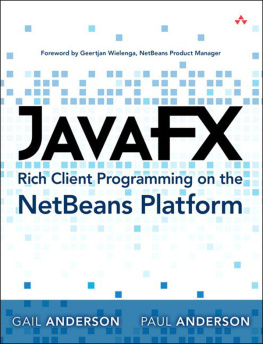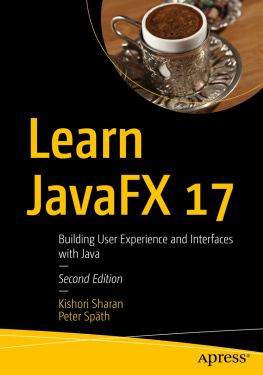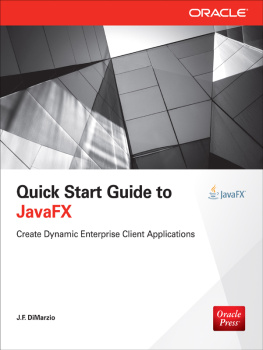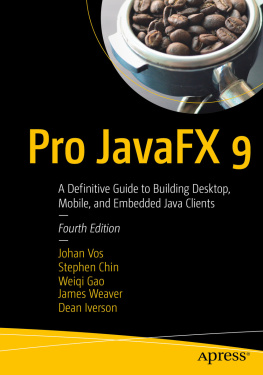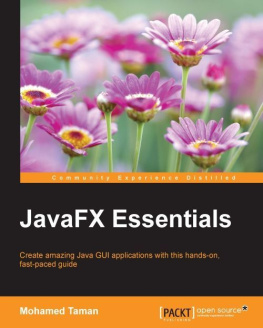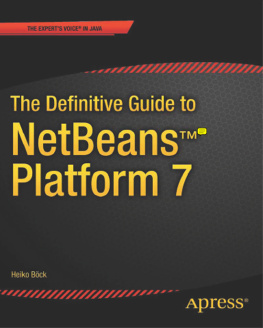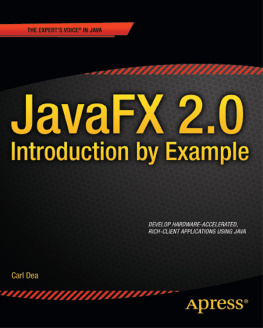About This eBook
ePUB is an open, industry-standard format for eBooks. However, support of ePUB and its many features varies across reading devices and applications. Use your device or app settings to customize the presentation to your liking. Settings that you can customize often include font, font size, single or double column, landscape or portrait mode, and figures that you can click or tap to enlarge. For additional information about the settings and features on your reading device or app, visit the device manufacturers Web site.
Many titles include programming code or configuration examples. To optimize the presentation of these elements, view the eBook in single-column, landscape mode and adjust the font size to the smallest setting. In addition to presenting code and configurations in the reflowable text format, we have included images of the code that mimic the presentation found in the print book; therefore, where the reflowable format may compromise the presentation of the code listing, you will see a Click here to view code image link. Click the link to view the print-fidelity code image. To return to the previous page viewed, click the Back button on your device or app.
J AVA FX
R ICH C LIENT
P ROGRAMMING ON THE
N ET B EANS P LATFORM
G AIL A NDERSON P AUL A NDERSON
Saddle River, NJ Boston Indianapolis San Francisco
New York Toronto Montreal London Munich Paris Madrid
Capetown Sydney Tokyo Singapore Mexico City
Many of the designations used by manufacturers and sellers to distinguish their products are claimed as trademarks. Where those designations appear in this book, and the publisher was aware of a trademark claim, the designations have been printed with initial capital letters or in all capitals.
The authors and publisher have taken care in the preparation of this book, but make no expressed or implied warranty of any kind and assume no responsibility for errors or omissions. No liability is assumed for incidental or consequential damages in connection with or arising out of the use of the information or programs contained herein.
For information about buying this title in bulk quantities, or for special sales opportunities (which may include electronic versions; custom cover designs; and content particular to your business, training goals, marketing focus, or branding interests), please contact our corporate sales department at or (800) 382-3419.
For government sales inquiries, please contact .
For questions about sales outside the U.S., please contact .
Visit us on the Web: informit.com/aw
Library of Congress Control Number: 2014947363
Copyright 2015 Anderson Software Group, Inc.
All rights reserved. Printed in the United States of America. This publication is protected by copyright, and permission must be obtained from the publisher prior to any prohibited reproduction, storage in a retrieval system, or transmission in any form or by any means, electronic, mechanical, photocopying, recording, or likewise. To obtain permission to use material from this work, please submit a written request to Pearson Education, Inc., Permissions Department, One Lake Street, Upper Saddle River, New Jersey 07458, or you may fax your request to (201) 236-3290.
ISBN-13: 978-0-321-92771-2
ISBN-10: 0-321-92771-0
Text printed in the United States on recycled paper at RR Donnelley in Crawfordsville, Indiana.
First printing, September 2014
Contents
Foreword
The NetBeans Platform abides, is what the Dude in the Big Lebowski might have said, had he known about the NetBeans Platform at all, which he probably did, somehow. Over the years, an incredibly wide range of applications have been built on top of the application framework that is the NetBeans Platform, from air defense systems at NATO to medical applications at Stanford, from military software at Northrop Grumman to software development tools at Oracle... and hundreds, probably thousands, of other applications in between.
Even whilst the uninitiated queried the relevance of the NetBeans Platformat first challenging NetBeans Platform users with what about the browser? and then a few years later with what about mobile devices?those using the NetBeans Platform have always known its applicability to the niche in which it fits so well. There will always be a need to put together modular applications that run on the desktop, and cross-platform portability will always be a predominant concern, making Java in combination with the NetBeans Platform a uniquely well-suited environment for serious application developers.
There certainly is something deeply intellectual about working with the NetBeans Platform. Once youre out of the woods of the initial learning experience, you will discover that youre not only figuring out how to construct a puzzle out of a disparate set of pieces, but that the pieces themselves are objects that youre constructing. Theres a meta-level of enjoyment that is a strangely distinct feature of progressing in your understanding of the NetBeans Platform and all it provides.
Moreover, as this book shows throughout, what Swing and JavaFX have in common is that theyre UI toolkits, not application frameworks. Neither of these toolkits provides any infrastructure to connect the pieces together. The NetBeans Platform is an application framework for both toolkits, either separately or together. In fact, as you will quickly learn in this book, the NetBeans Platform is a meeting point that unites the stability and depth of experience that Swing developers bring to the table together with the innovation and the rich content that the JavaFX world provides.
I wish you a lot of fun as you acquire new knowledge with the NetBeans Platform, while learning how to create meaningful applications in Java.
Geertjan Wielenga
NetBeans Product Manager
Preface
The NetBeans Platform provides a rich client framework to build desktop applications in Java and JavaFX. Its design has a certain symmetry and elegance. As you use its many APIs, each new feature learned will become familiar. Youll learn that this familiarity, coupled with code and design reuse, is a good trait.
Simply stated, the NetBeans Platform will save you years in building and maintaining application framework code. Even the simplest NetBeans Platform application has amazing features. And the platforms best feature is that as users change and technology and requirements evolve, your application can evolve, too.
Our Approach
This book takes a holistic approach to presenting the NetBeans Platform. We begin with the basic Java architectural tenets of event notification, JavaBeans property support, and UI responsiveness with background tasks. As we build upon these Java basics, we present the NetBeans Platform APIs and features in the context of small sample applications. For example, you will learn how the Nodes API, Action framework, Lookup API, and modular architecture all contribute to the overall design of a CRUD-based database application. Our examples are relatively small and familiar, so you can spend more time learning the NetBeans Platform APIs and not our application business logic.
We wanted to write a book that pulls together many of the excellent NetBeans Platform tutorials and documentation so that you dont have to search for examples. To that end, we provide you with a lot of sample code including screen shots and step-by-step instructions to help you on your journey.
And finally, this book is not just about the NetBeans Platform. With this text, we want to encourage Swing programmers out there to take the plunge with JavaFX. If you want to leverage the ease and beauty of JavaFX, the NetBeans Platform can help you transition from a Swing UI to a JavaFX UI as you develop applications. In fact, the modular architecture of the NetBeans Platform is a great vehicle for easing into JavaFX. Pinpoint your requirements that fit well with JavaFX and start there. Do your visualization requirements include charts or perhaps 3D? Maybe youd simply like to have stunning effects, such as linear gradients, drop shadows, or animations. Pick and choose all you want, but know that youll still have the underpinnings of a modular, well-designed NetBeans Platform application.

